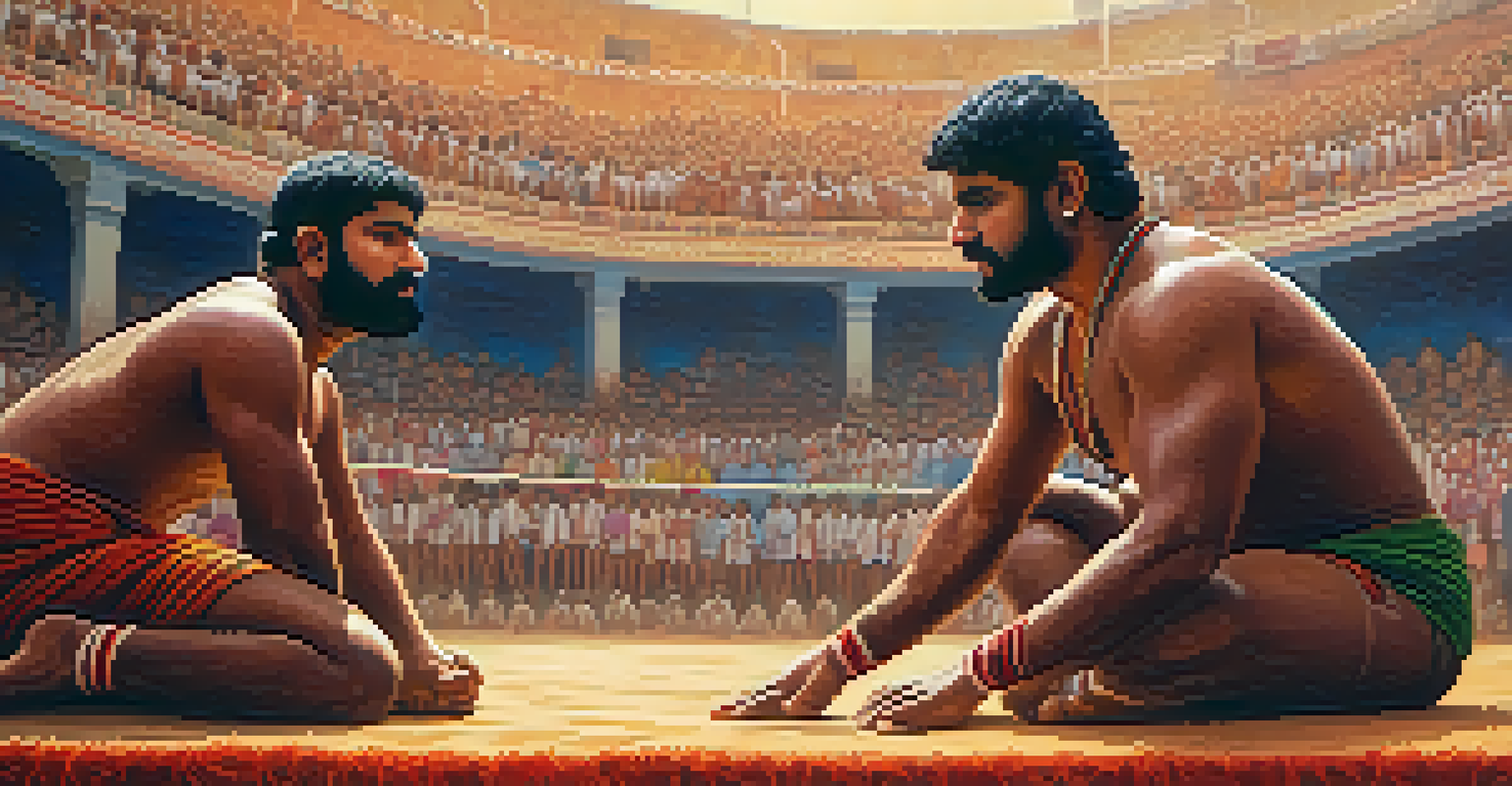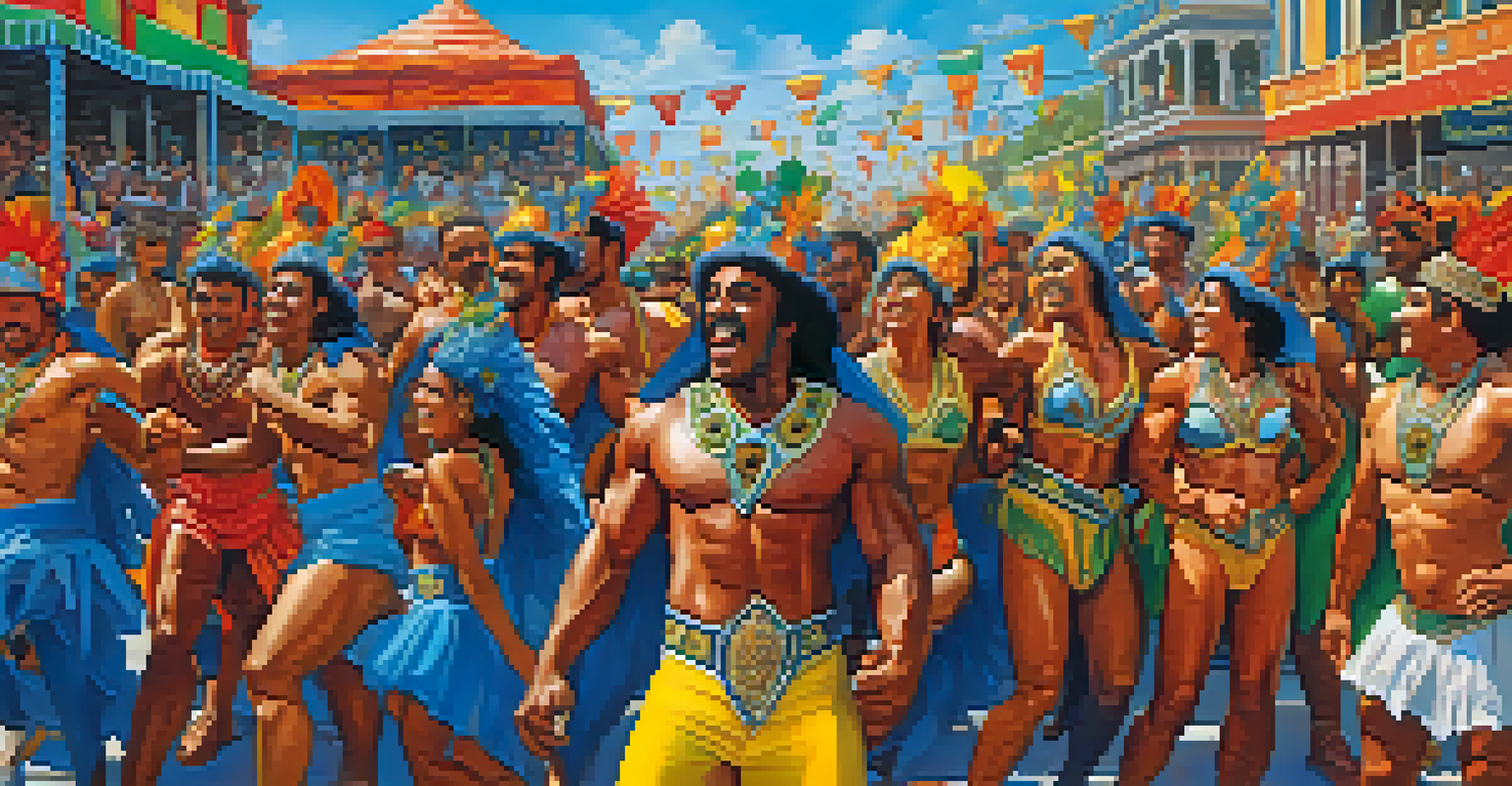Cultural Influences on Bodybuilding: A Global Perspective

Historical Roots of Bodybuilding in Different Cultures
Bodybuilding has a rich history that varies across cultures, with each having its own approach to physical fitness. For instance, ancient Greece revered the human form, celebrating athletes during the Olympic Games, which fostered an early appreciation for strength and aesthetics. Meanwhile, in India, traditional wrestling known as 'Kushti' has been practiced for centuries, highlighting the importance of physical prowess.
Strength does not come from physical capacity. It comes from an indomitable will.
These historical practices laid the groundwork for modern bodybuilding, showcasing how cultural beliefs about strength and beauty evolve over time. In many cultures, physical fitness was often tied to survival, whether through agriculture or warfare, emphasizing the real-world applications of strength. This historical context provides a backdrop for understanding contemporary bodybuilding's diverse forms.
As bodybuilding continues to grow globally, these cultural roots influence how individuals perceive fitness today. Different regions adopt various training methods, diets, and ideologies, reflecting their unique heritage and values. This interplay between history and modern practices enriches the bodybuilding community, offering a tapestry of influences.
Cultural Perceptions of the Ideal Body
What constitutes the 'ideal' body varies significantly around the globe, influenced by cultural norms and values. In Western cultures, a muscular physique often symbolizes strength and health, while in other regions, such as parts of Africa, a fuller body may be viewed as a sign of wealth and prosperity. This divergence in ideals illustrates how culture shapes our understanding of attractiveness.

For example, in Japan, there is a growing trend towards a leaner, more toned physique, reflecting shifts in societal values and health consciousness. In contrast, Brazilian culture often celebrates voluptuous bodies, which can be seen in their vibrant carnival celebrations. These differing ideals not only impact individual aspirations but also the marketing and promotion of bodybuilding.
Cultural Roots Shape Bodybuilding
Bodybuilding's history is deeply influenced by various cultures, each contributing unique practices and beliefs about fitness and strength.
Understanding these perceptions is crucial for bodybuilders and fitness enthusiasts alike, as it helps to navigate their own goals within a broader cultural context. It also highlights the need for inclusivity in fitness communities, recognizing that beauty and strength come in diverse forms. Ultimately, embracing this variety can enrich the bodybuilding experience for everyone.
The Role of Media in Shaping Bodybuilding Culture
Media plays a pivotal role in shaping perceptions of bodybuilding and fitness culture worldwide. From magazines to social media platforms, the portrayal of bodybuilders can create aspirational figures that influence people's goals and self-image. This exposure can be both positive and negative, as it often sets unrealistic standards of perfection that many strive for.
The body is a sacred garment.
In recent years, platforms like Instagram have transformed how bodybuilders share their journeys, fostering a sense of community and support. However, they also contribute to the phenomenon of comparison, where individuals may feel inadequate when measuring themselves against heavily edited images. This duality highlights the importance of critical media consumption and self-acceptance.
Moreover, the rise of diverse voices in media is beginning to challenge traditional narratives around bodybuilding. More athletes from various backgrounds are sharing their stories, emphasizing that strength comes in many forms. This shift is vital for creating a more inclusive environment within the fitness community, where individuals can find inspiration in their own unique journeys.
Dietary Influences on Bodybuilding Across Cultures
Diet is a cornerstone of bodybuilding, and cultural influences significantly shape dietary practices around the globe. In the United States, high-protein diets, often featuring lean meats and supplements, dominate the bodybuilding scene. Meanwhile, many Mediterranean cultures emphasize whole foods, including grains, legumes, and healthy fats, showcasing a different approach to nutrition.
In Asia, traditional diets rich in rice and vegetables are often complemented by unique protein sources, such as tofu or fish, which provide essential nutrients for muscle growth. These cultural dietary practices not only reflect local agricultural practices but also showcase the diverse ways individuals fuel their bodies for optimal performance.
Media Influences Bodybuilding Norms
The portrayal of bodybuilders in media shapes public perceptions and aspirations, often setting unrealistic beauty standards.
Understanding these dietary influences can empower bodybuilders to adopt a more holistic approach to nutrition. By exploring different cultural cuisines, individuals can discover new, nutritious foods that align with their fitness goals. This cultural exchange not only enriches the bodybuilding experience but also promotes a more inclusive understanding of health and nutrition.
Cultural Norms and Gender Roles in Bodybuilding
Cultural norms and gender roles profoundly impact participation in bodybuilding, influencing who feels empowered to pursue this sport. In many Western cultures, the image of the muscular male bodybuilder often overshadows women's contributions to the sport. However, in other cultures, women are celebrated for their strength, challenging traditional gender norms and inspiring new generations of female athletes.
For instance, in countries like China, female bodybuilders have gained recognition in recent years, reflecting changing attitudes toward women's physical capabilities. Conversely, some cultures may still impose restrictions on women's participation in strength sports, viewing it as unfeminine or inappropriate. This disparity underscores the need for advocacy and support to ensure equal opportunities for all athletes.
Furthermore, the rise of inclusive events and competitions is helping to break down these barriers. By showcasing diverse athletes, organizations can promote the message that strength knows no gender. As the bodybuilding community continues to evolve, embracing diversity will be key to fostering a more inclusive environment for everyone.
The Impact of Globalization on Bodybuilding Trends
Globalization has significantly influenced bodybuilding, allowing trends and practices to cross borders at an unprecedented rate. This interconnectedness has led to the emergence of hybrid training styles and diet plans that blend influences from various cultures. For instance, the popularity of CrossFit has introduced elements from Olympic weightlifting to a broader audience, creating a melting pot of fitness practices.
However, this globalization can also lead to the homogenization of bodybuilding culture, where unique local practices are overshadowed by dominant trends. As a result, traditional methods and beliefs may be lost in favor of more widely accepted practices. It's essential to recognize and celebrate these unique cultural elements to preserve the rich diversity of bodybuilding.
Community Enhances Bodybuilding Journey
Supportive communities, both in-person and online, play a crucial role in motivating and connecting bodybuilders across different cultures.
Moreover, the global exchange of information allows athletes to learn from each other, fostering innovation in training techniques and nutrition. This sharing of knowledge can empower individuals to tailor their bodybuilding journeys to suit their needs. Ultimately, embracing the benefits of globalization while honoring cultural uniqueness is key to the future of bodybuilding.
Community and Support Systems in Bodybuilding Cultures
Community plays a vital role in the bodybuilding journey, providing support and motivation for individuals to reach their goals. In many cultures, bodybuilding is not just a solitary pursuit but a social activity where individuals come together to share experiences and learn from one another. Gyms and local events often become hubs of camaraderie, fostering friendships that extend beyond the weights.
For example, in countries like Brazil, bodybuilding communities often celebrate competitions with vibrant festivals, creating an atmosphere of encouragement and support. These events bring together individuals from diverse backgrounds, showcasing the unifying power of fitness. This sense of belonging can be crucial for maintaining motivation and accountability.

Additionally, online communities are reshaping how bodybuilders connect and share their journeys. Social media platforms enable individuals to find support from like-minded enthusiasts worldwide. This global network fosters a sense of solidarity, allowing athletes to celebrate each other's successes, regardless of geographical boundaries. Ultimately, these communities enrich the bodybuilding experience, reminding us that we are stronger together.